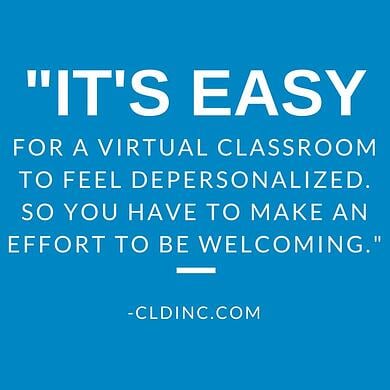
Providing Learning Objectives
To make sales training courses effective, you have to know your students have a certain baseline level of knowledge so you can determine the best training objectives. Not only should you define the prerequisites students bring to the virtual classroom, you should take the time to verify that students meet baseline requirements. Otherwise the entire course can be short-changed because one or two people have to catch up. That’s unfair to the class as a whole.
You should define learning objectives for your online sales training, and for each lesson you should answer the question “What’s in it for me?” from the students’ point of view. Objectives should be matched with specific lessons, and each lesson should have its own smaller objectives. Make clear to students how they will be evaluated on mastery of learning objectives.
Making the Virtual Classroom Welcoming
How do you make an online classroom feel welcoming? It’s easy for a virtual classroom to feel depersonalized, so you have to make an effort to be welcoming. Tell students a bit about yourself beyond your professional qualifications. Make sure students know how to use feedback tools and even things like emoticons, and if applicable, make sure everyone’s microphones work. Avoid asking vague, open-ended questions. People are more likely to speak up when asked specific questions, like “What do you do first in pre-call planning?”
Once you get to know your students and they get to know each other, you can build on their experiences. Encourage your students to share their own “lessons learned.” This can be great for sparking discussion and keeping the pace from dragging.
Keeping Trainees Engaged
Virtual sales training courses have to maintain students’ attention, and this can be challenging. Create strong introductions and conclusions to each lesson to start and end on a strong note. Divide content into defined, well-organized subtopics. Try not to use more than four or five slides without pausing for interaction with students.
Question-answer sessions, chat sessions, and polls are other feedback mechanisms that are valuable in online sales training. Different students have different learning and interaction styles, so try to mix lesson components. Use visuals, audio, and text. You can even assign small groups and have them work together in virtual meeting rooms.
Master Visual Representations
Visualizing content is essential to virtual sales training courses. Presenting students with wall after wall of text only produces boredom and doesn’t do much to help them master concepts and processes. When concepts must be communicated through text, try to give reading assignments for offline and have students return to class ready to discuss and apply what they read.
You don’t need a lot of “decorative” visuals. Rather, your visuals should illustrate concepts. You could, for example, demonstrate how a new app is used to order drug samples using static screen captures or screencasts. There are several free and paid screencast tools that make it easy to demonstrate processes to your students. This type of demonstration helps students create mental models of tasks they will be performing on the job.
Some Virtual Classroom Dos and Don’ts
• Do practice delivering lessons before you “go live” with a trusted friend or colleague to give you good feedback.
• Don’t leave long silences during lessons. If you’re going to take a minute or two to set up a visual aid, tell students what you’re doing so they know what’s going on and won’t suspect technical problems.
• Do include specific, regular feedback and interaction every three to five minutes during a lesson.
• Don’t answer complicated questions in the middle of presenting an concept. Acknowledge the question, tell the student you will return to it, and do so once you’re at a natural stopping place.
• Do use a mix of media to engage all types of learners and keep things from getting boring.
• Don’t confuse organization with dullness. A very orderly lesson can still include enlightening anecdotes, visual aids, and examples.
Virtual classroom training offers amazing convenience, time savings, and savings on travel expenses. As workforces become more distributed, online sales training is becoming more popular, particularly since technology allows for exciting and engaging presentation. At CLD, Inc., we excel in developing virtual sales training courses to meet the specific needs of the pharmaceutical and biotech industry. CLD is uniquely positioned to offer you the most effective training programs available, and have been doing so for over 35 years. To learn more, please get in touch with us. We would be more than happy to answer your questions.




